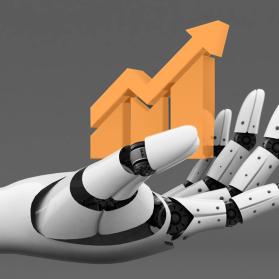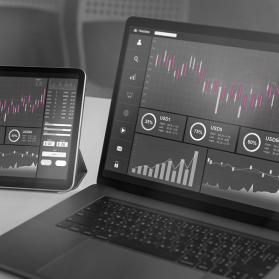Digitalization and automation – Deutsche Telekom’s procurement department has already established an excellent position in this respect. Karim Ouali, VP Procurement, Steering, and Digitalization at Deutsche Telekom, talks in an interview with Detecon consultants Michael Meissner and Dominik Söhnle about the journey there and how he envisions modern procurement practices.
We consider digital efficiency to be one of the major topics of the future. Digitalization and automation are two indispensable concepts in this context. Where do you and Deutsche Telekom draw the line between digitalization and automation? And what changes do you think will occur because of digitalization?
Karim Ouali: Automation is the first step after electronic data processing. In this sense, automation means using machines rather than people to perform non-value-adding activities. The main objective is to become more efficient, which is why one of the trade-offs of automation is quality. Quality often declines as the degree of automation rises. While we may have become more efficient because of automation, I would be cautious about making a general claim that it automatically makes us better.
For me, digitalization goes one step further: the data that have been produced are processed intelligently. An increase in efficiency is not the aim of digitalization. Rather, it is perhaps a secondary product. The main objective of digitalization is to achieve greater output, which can be in savings, the risk landscape, or quality.
Having spent the last ten to twelve years realizing automation, we have achieved substantial progress in this area. Now we are focusing on digitalization, especially in the area of strategic sourcing. And our mission here is to generate savings and increase output. We are convinced that digitalization can be a major lever for accomplishing our goals.
Operating processes continue to focus relatively strongly on automation issues, i.e., on increasing efficiency. Strategic procurement has set different priorities for digitalization and output orientation. Could you go into a little more detail about this?
The core activities in operating procurement are automated. They include order creation, invoice payment, or invoice verification. As far as these activities are concerned, we have come a long way. In strategic procurement, the core task is digitalized, but not automated. Nevertheless, we have secondary activities, i.e., non-value-adding activities in strategic procurement, that we can also automate; one example is the documentation of the results of the contract award process. When the terms of the contract have been fully negotiated, we don’t need to ask an expensive procurement agent to create the contract in SAP. A bot can do that just as well. The activities required for the preparation and conduct of negotiations by the agent can and should be digitalized. You can give agents smart data for analysis that will strengthen their negotiating position. But I don't expect the position of strategic procurement agent to be eliminated by digitalization.
When it comes to procurement analytics, you have concentrated strongly on gathering different data and information while using very different tools and methods. What relationship to digitalization do you see here?
Successful procurement organizations will be characterized by their not halting at the production of relevant data; they will also process these data intelligently. That makes the topic of data analytics the key enabler of digitalization. It is in fact at the heart of digitalization.
However, data cannot be processed until they have been produced. Processes must be standardized. We have already reached this stage. Moreover, we have also implemented Ivalua, a standardized transactional procurement landscape. The system that is used is irrelevant – but it is important to have a platform because this is what maintains the standardization of processes.
The operating world with SAP and the sourcing landscape with Ivalua are two major producers of information. They generate massive amounts of data that can be processed very quickly and efficiently by using a smart analysis platform. In the meantime, we are in the process of combining our own data with data from external sources such as risk management platforms or rating agencies. If the internal and external data are in correlation, we prepare our negotiations differently.
Do you need a certain level of automation to lay the required foundation for subsequent digitalization?
Not necessarily. Having structured data is important for digitalization. They can be obtained from standardized processes, master data, and a machine in which transactional data are entered. If these processes have been automated, all the better. Then we can concentrate on data analysis. But automation per se is not essential for digitalization whereas data production is.
Data-driven procurement – that sounds like a paradigm shift in the way you can work with such large amounts of information. How do you see it?
The question is always what I do with the data. Digitalization offers new business models, but we cannot turn procurement upside-down overnight. Nevertheless, data and digitalization offer to the procurement department an opportunity to perform differently.
In a data-driven organization or in data-driven procurement, for example, the preparation of price negotiations is based on data analysis. This would tell me what percentage of margin and risk position is included in the demanded price and how many euros should not be exceeded.
After completion of the data analysis, i.e., the correlation of our internal with external data, a data-driven organization is alerted; for instance, as soon as the data determine that a supplier’s annual financial statements are about to be issued, negotiations for a new contract can be launched at an early stage.
We do not rationalize procurement, but shift instead the tasks. The core task is the generation of solid arguments based on data analysis and facts and not the face-to-face negotiations. Successful negotiations with suppliers are otherwise not possible.
We are not yet doing this systematically across the board because we are just now taking our first steps in the direction of a data-driven organization. Still, we have our vision and a plan and we are slowly working toward their realization.
What about the converse case – the supplier also has this transparency about its data and demands an adjustment of the prices? Could you not find yourself in a situation in which prices are ultimately based on current daily data despite the existence of framework agreements with suppliers?
You must lay your cards on the table here as well. In the end, however, the question is this: Who is faster? So although we negotiate when we see an opportunity arising tomorrow, we also take action when we recognize, for example, that oil prices will rise in one year and seek to stabilize prices for three or four years.
The key is to stay one step ahead of the supplier. Of course, we can’t always win. There will be times when a supplier is one step ahead of us. If, however, suppliers and customers have full and equal transparency and are both working towards target costing, they can combine their strengths to create a different kind of added value and concentrate on innovations or better quality, for example. Unfortunately, the focus at this time is often solely on price. If we can manage to move in the direction of target costing, we will have achieved an initial victory and can talk about other dimensions in partnership with suppliers. So I don't see it as a risk. It is a risk if only the supplier makes this move and we do not.
But not only the data derived using your own tools and processes are used. There are numerous external sources of data that are meaningful and even necessary such as knowledge about the supplier’s annual financial statements, creditworthiness, and the cost of raw materials. When you think of data-driven procurement – what are these dimensions?
That is the key question because the dimensions do not end. We have started to structure our internal data and now have good transparency about our spending in all dimensions. We draw on external sources to obtain information about the risk situation per supplier, i.e., what suppliers have problems in what areas. Metadata about suppliers – for example, when the annual financial statements become available – are procured from rating agencies.
Breakdowns or the breakdown structure of the products are important, however. What raw materials does a product contain and which of them is the cost driver? Now we are talking about procurement engineering. These data must be acquired through research. When I know what raw materials are found in a product, I can in turn buy data and monitor the commodity exchanges to see how the price of one of these raw materials is developing and what trends can be seen. This step of procurement engineering is essential.
My vision is to go into all these dimensions and obtain a lot more data than just the information that “the contract is about to expire” – fully aware that a human being will never in a lifetime be able to process this mass of data. At the same time, I am working on a platform that correlates these data with the goal of identifying opportunities and risks that the machine in turn translates into instructions for action. This, too, is digitalization. I am not automating a previously existing task, but adding a new step that a human being cannot do. I need the power of the machine to complete the data processing. I am convinced of the value of this idea and confident that we will succeed. Initial success strengthens my conviction.
This way of working – data-driven, systematically preparing and structuring all the information, and launching a fact-based discussion with suppliers on an equal footing – is a major change. Doesn’t it demand skills and abilities that are completely different from what many procurement agents currently have to offer?
Definitely. Not every agent today has the ability to perform data analytics, understand data and relationships, and act accordingly. Tackling the skills issue is the simpler matter, however. We can train these employees or supplement the team with people who bring the required skills with them.
Things look different when it comes to understanding and willingness. If the agents aren’t willing, we have a problem. The issue of willingness is just as important, if not more important, than the question of skills. This topic must be approached tactfully. We have to demonstrate that agents also have something to gain from the new procedure. The employees must see that it works. Above all, they must also believe the data. Trust in automatic data processing is not gained through training, but only through a change program – and that is what we are doing now.
What comes next? Can you imagine the implementation of smart contracting to such an extent that contracts adjust themselves if, for example, the price of a raw material becomes volatile?
That is conceivable. But this is not a revolution in my eyes. As I see it, smart contracting would be the logical continuation for the automation of something that is already being done. When I think about my vision for the future, I ask myself certain questions. How do we negotiate? How are the requirements defined? And this is where I draw an arc in the direction of blockchain.
Today’s supply chains are linear. We, the end customers, negotiate solely with the original equipment manufacturer (OEM) who in turn negotiates with sub-suppliers. Speaking technologically and using blockchain, it is possible to develop from a linear supply chain to a supplier network. Our needs are displayed on the internet. A supplier network that can satisfy these needs is spun.
I don’t know whether this will ever actually be implemented in our company. It would mean a reduction of the engineering depth to 10 percent. And our engineers in Germany are especially proud of the stamp “Made in Germany.” If we as an ICT company now say that we have the best engineers, but still have the whole supply network for a new technology designed “externally,” we will bruise a lot of egos. Our colleagues will not accept this overnight. Nevertheless, from the procurement perspective, I see the revolution in this field in perhaps 10 or 15 years. Everything else is evolution: becoming ever faster, more efficient, and more transparent step by step.
Thank you for the insightful interview!







